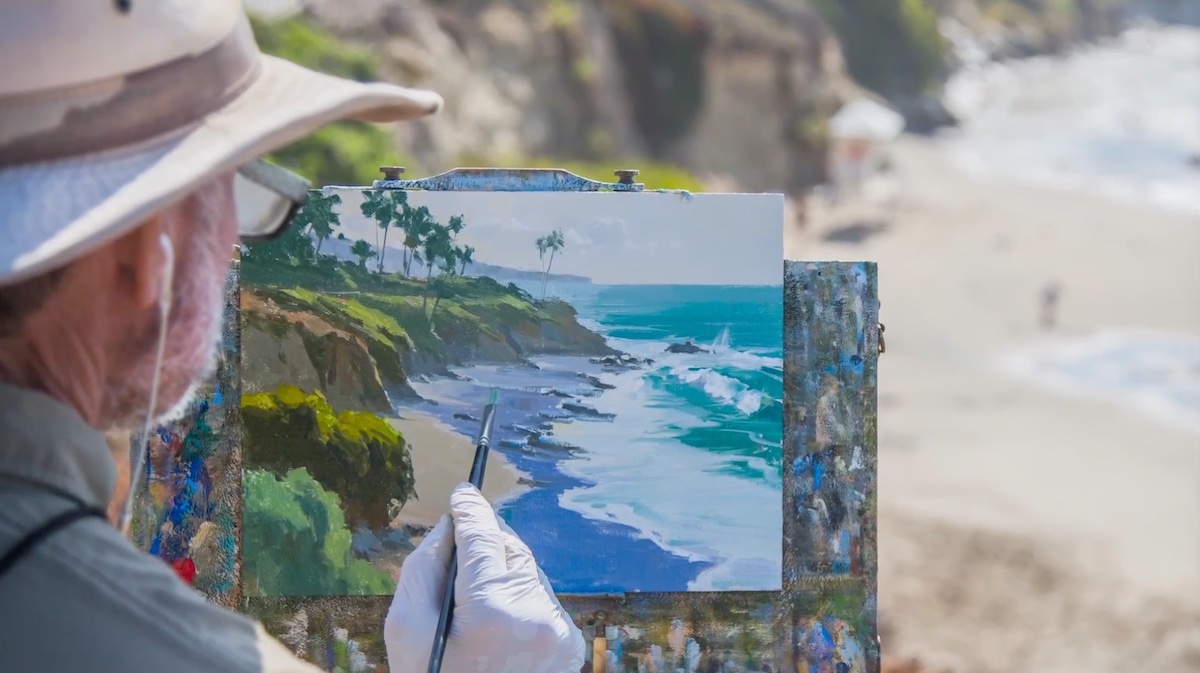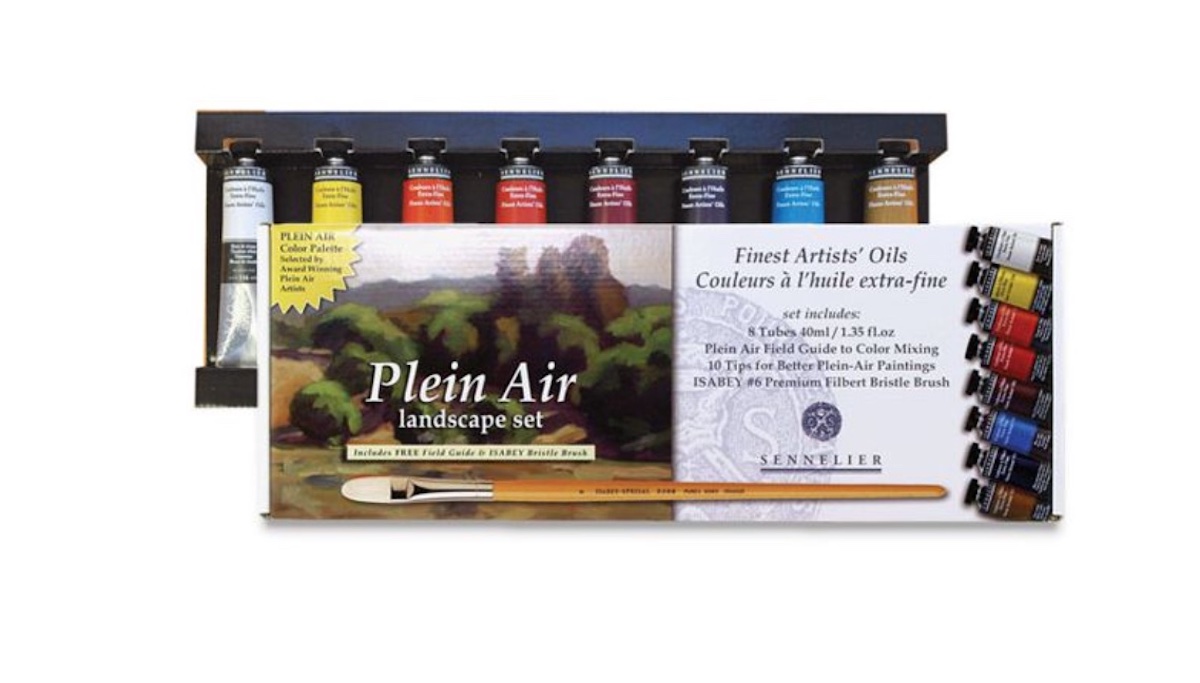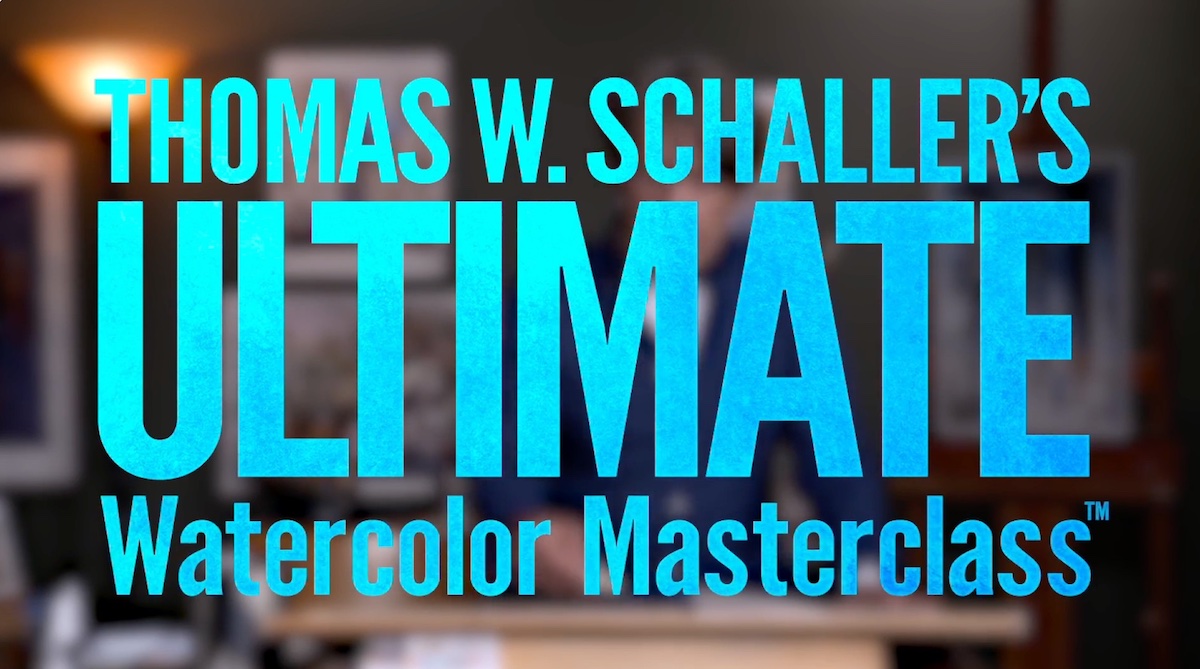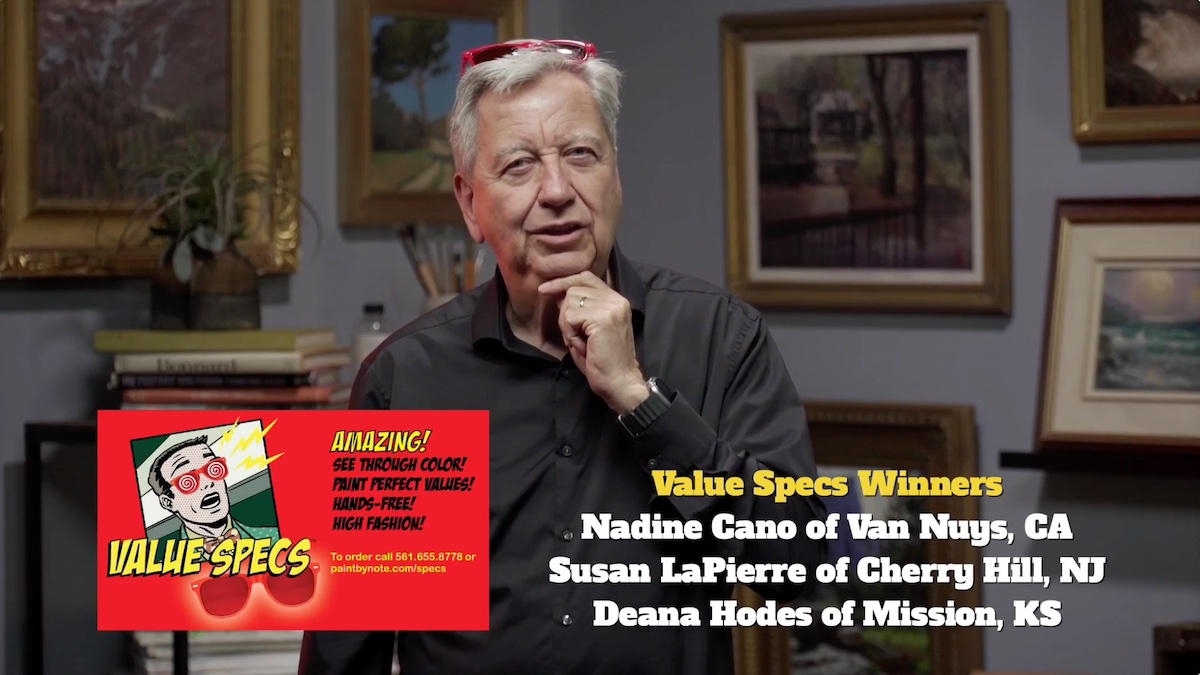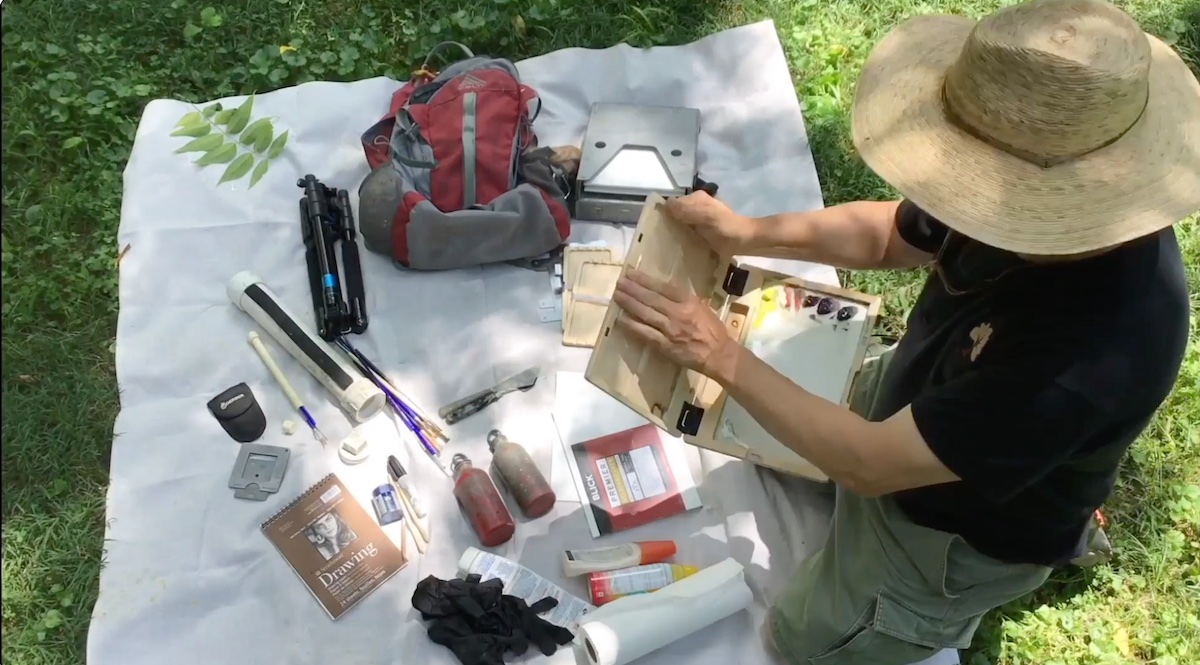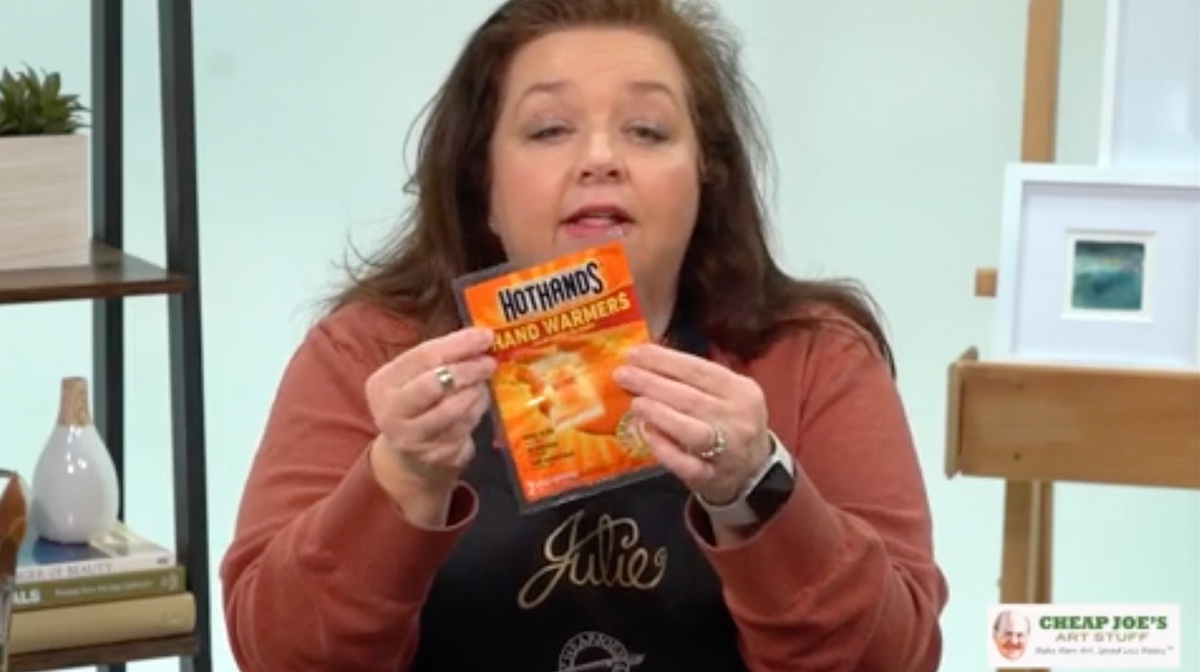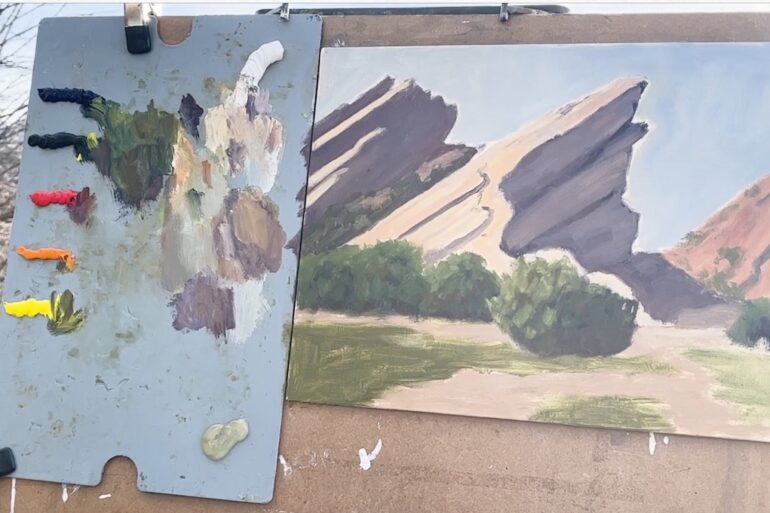
This post is also available in:

Welcome back to the lively and warm world of Streamline Publishing, which kicked off the fourth edition of Plein Air Live, the event entirely dedicated to plein air painting.
The pre-convention day began with the usual Beginner’s day, which, as already anticipated in the last edition of Watercolor Live, took on the -more fitting- wording of “Essential Technique day”: a day entirely dedicated both to those who want to dare experimenting with plein air painting, and to those who want to consolidate their basics and technique, because you know: there is always something to learn at these events.
The day, orchestrated as usual, by Eric Rhoads -The Man behind all the Streamline Publishing events- and the well-known face of Kelly Kane, showed not only a multiplicity of useful information such as organizing the materials needed for outdoor painting, but also the execution of plein air paintings with the many different mediums: from oil to watercolor, from pastel to gouache.
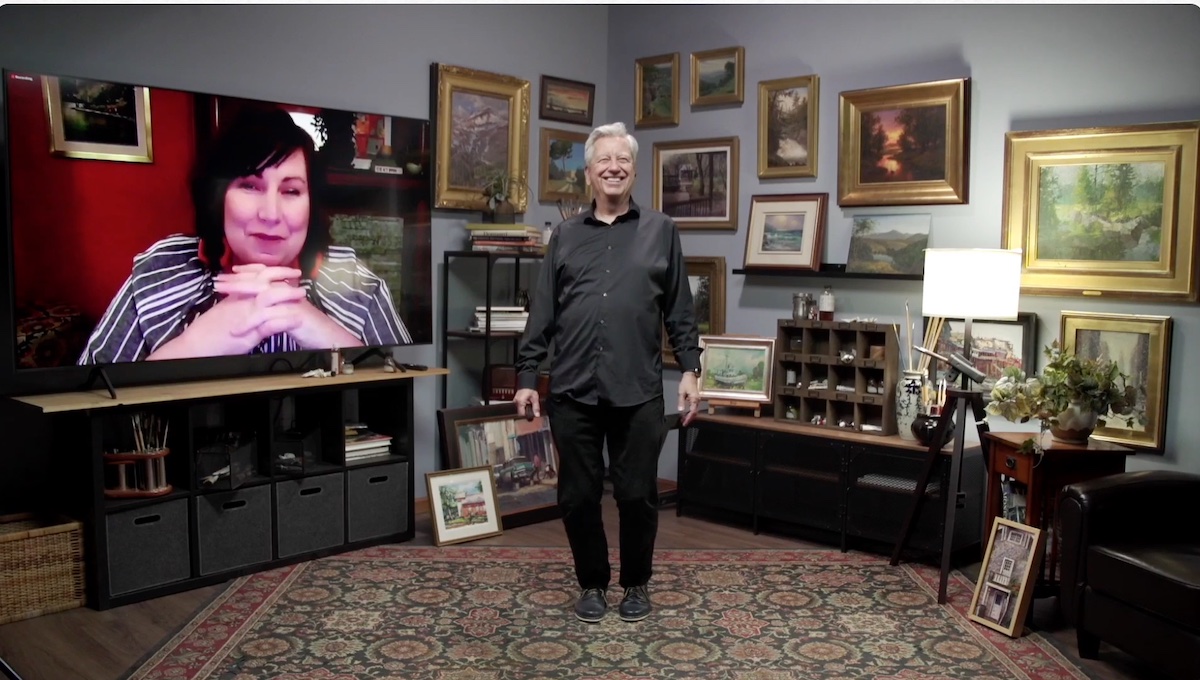
Doing the honors was Paul Kratter, a California artist with a long history in the illustration environment. For the demonstration session, he depicted a composition of eucalyptus trees, emphasizing the importance of making quick preliminary sketches, which he categorically does in pen because he likes to see construction lines in the background.
The preparatory sketches are a key part of the process, not only to bring the compositional structure into focus but also to establish the scale of tonal values, which is essential to the success of the work.
Inspired by the work of a number of California Impressionists, such as Percy Gray, Edgar Payne, Sam Hyde Harris, and William Wendt, Kratter works on linen applied to a wooden panel on which he habitually underpaints with ochre color on which he blocks in shapes. He paints starting from the front ground and then moving to the background.
With a flat brush he made the foliage of the trees: a set of short brush strokes, with the brush tilted at a 45-degree angle, which he overlaid with small variations of color that emphasize the perspective depth of the foliage. For the undergrowth, on the other hand, he laid down long, even brushstrokes. Subsequent color layering is interspersed with neutralization of complementary colors so that the composition is harmonious. He focused on defining the sky for which he also used greens from the palette, harmonizing and softening the edges of the foliage. To finish, he added brush strokes to highlight highlights and details. When drafting color, according to Kratter, it is important to take into account three parameters that define the composition: lighter or darker, warmer or cooler and brighter or duller colors.” Taking this into account, he advised, especially for those who are beginning to venture into the world of plein air painting, to start with extremely simple, small-format compositions, taking care to step back from the composition frequently to observe it as a whole. “Don’t be in a hurry when you paint, you can take your time especially if you are just starting out,” said the artist who said how the ratio of bad drawings to excellent drawings increases the more you draw. Kratter, who paints in oils has also been the face of Sennelier: his palette never lacks some of the famous French brand’s colors, among them: Indian Yellow Orange, Chinese Orange and King’s Blue, which he also routinely uses as a neutral.
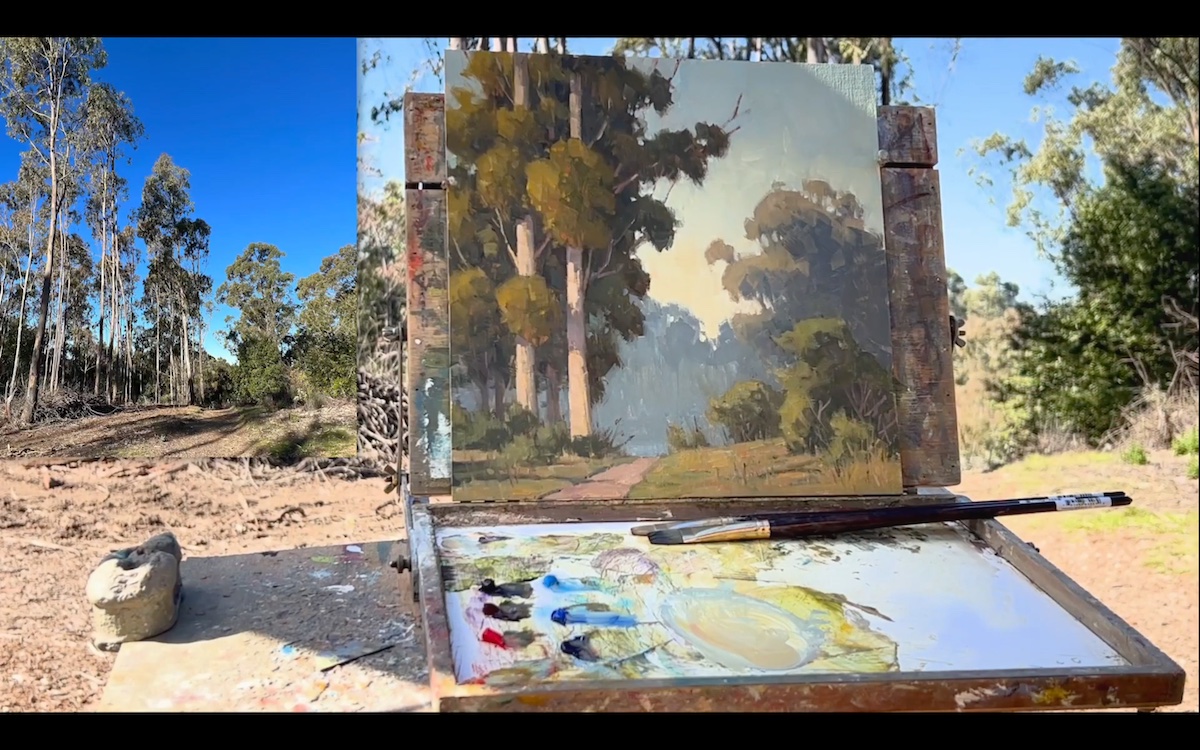
Watercolorist Geoff Allen, who recently received the Award of Excellence at the Laguna Plein Air Invitational 2022 and Best of Show at the “Waterworks” exhibition at the Laguna Plein Air Painters Association Gallery, depicted a distinctive California wooden porch. Allen is wont to begin the composition with a pencil drawing, with which he makes a simple study of tonal values and on which he later spreads a first, very dilute wash, with a large brush. After applying a second wash he begins to work on the individual elements which he harmonizes on finishing starting with saturated colors that he gradually desaturates.
According to Allen, “connection” is the key word to keep in mind when making a composition and that it occurs from the connection of large simplified forms. In order to engage in painting, regardless of whether it is plein air painting, according to Allen, it is essential to “feel the paper” and find your own brushes so that you can move confidently across the paper: “Once you start making your own brushes there is no end,” said the artist who likes to use old brushes plucked to create tree foliage thus shaping his perception of the image. To create the work he worked wet on wet spraying water from time to time to keep the paper moist:” moisture buys you time,” said the artist. As a good watercolorist Allen stated that he makes short brush strokes to avoid unpleasant drawbacks in the sheet that can bend creating unpleasant wavy effects. Regarding the definition of the details he made at the end of the composition he said, “every little detail draws the viewer’s interest thus making it a focal area and I like to leave pathways for the eye too and any break in a dark structural shape lets the viewer travel around,” said the artist.
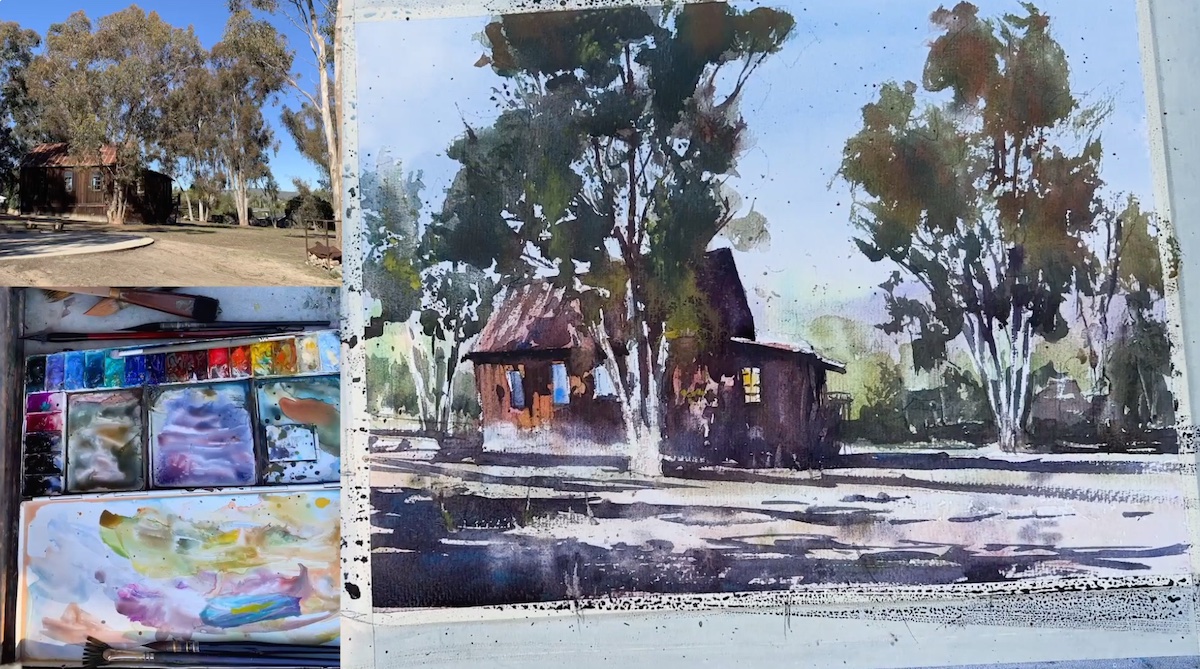
British artist Clare Bowen took participants through the beautiful meandering seas of Cornwall, where she lives. Passionate about maritime scenes, she depicted a boat that, at the end of the composition, abandoned its mooring. If for Allen the magic word was “connection,” for Bowen “simplification” is the key with which to approach plein air painting.
While for the compositional study she helped herself with the classic square that defines part of the scene, for the drafting of the colors she relied on a limited palette consisting of the only three primary colors and white -which she suggests storing in the freezer to keep them fresh- with which she made a multiplicity of other colors, simplifying the subject of which she sculpts the edges to perfect the forms. According to Bowen, using a limited palette is very helpful in familiarizing himself with composition.
In her compositional process she often controls the compositional ratio by helping herself with the brush while for defining tonal values she relies on a “value specs” (the one created by Eric Rhoads and available on the Streamline Publishing website, is very handy and useful). She later started with the shape block with which she established a relationship between tonal values from mid tones.
Bowen, who focused on the importance of relating everything, invited participants to begin by depicting very simple scenes made at particular times of the day that correspond neither to sunrise nor sunset, when sudden changes in light can create problems for the inexperienced. “Part of the joy of being a painter is that you can choose the story to be told, the light, the colors, the details to be emphasized, starting with the fact that everything revolves around the importance of tonal values and color temperature, because it’s all about the right tonal value and the right color temperature,” said the artist.
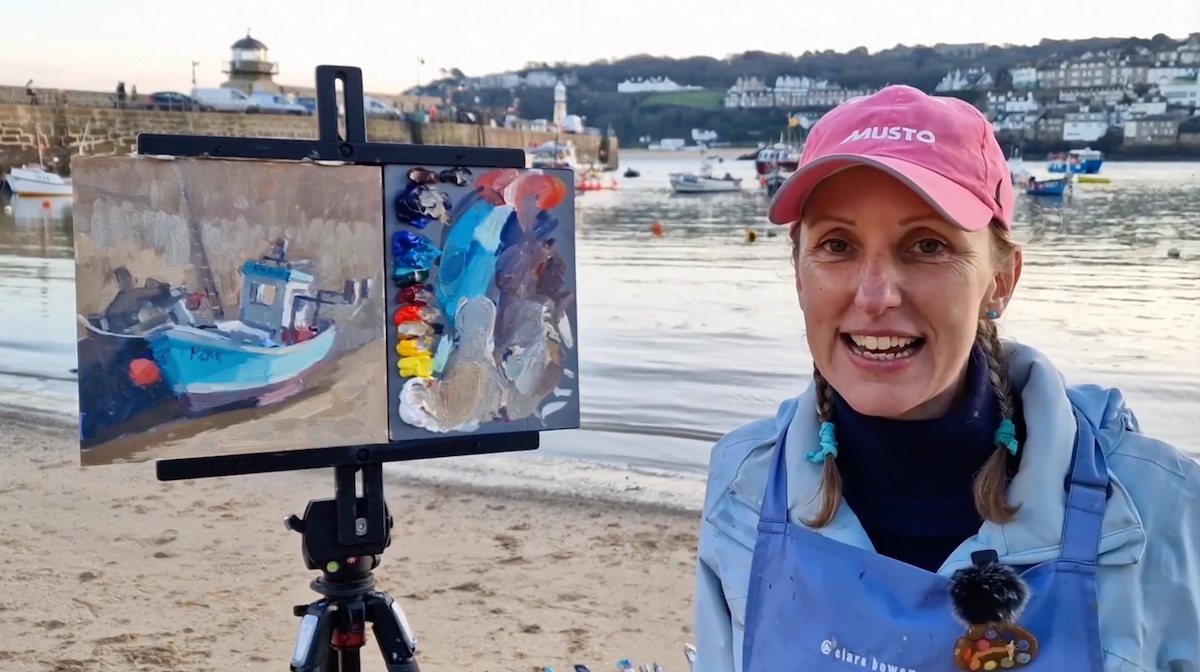
For those who do not yet know, Eric Rhoads, in addition to being a great speaker and showman is also a passionate plein air artist with decades of experience behind him. Those in the audience who have had a chance to attend a few Streamline Publishing events know his story well. At the Essential Technique day Rhoads answered, taking into account his personal experience and years of experience dealing with a remarkable variety of painters, the questions of the attendees, doling out practical advice on how to approach Plein Air painting: from the materials needed to what to take into account during the painting session, to the motivation that drive toward Plein Air painting and the importance of embracing even the moments of discomfort that are part of the compositional process. A personal curiosity: Rhoads considers time and waiting as two personal enemies during plein air sessions.
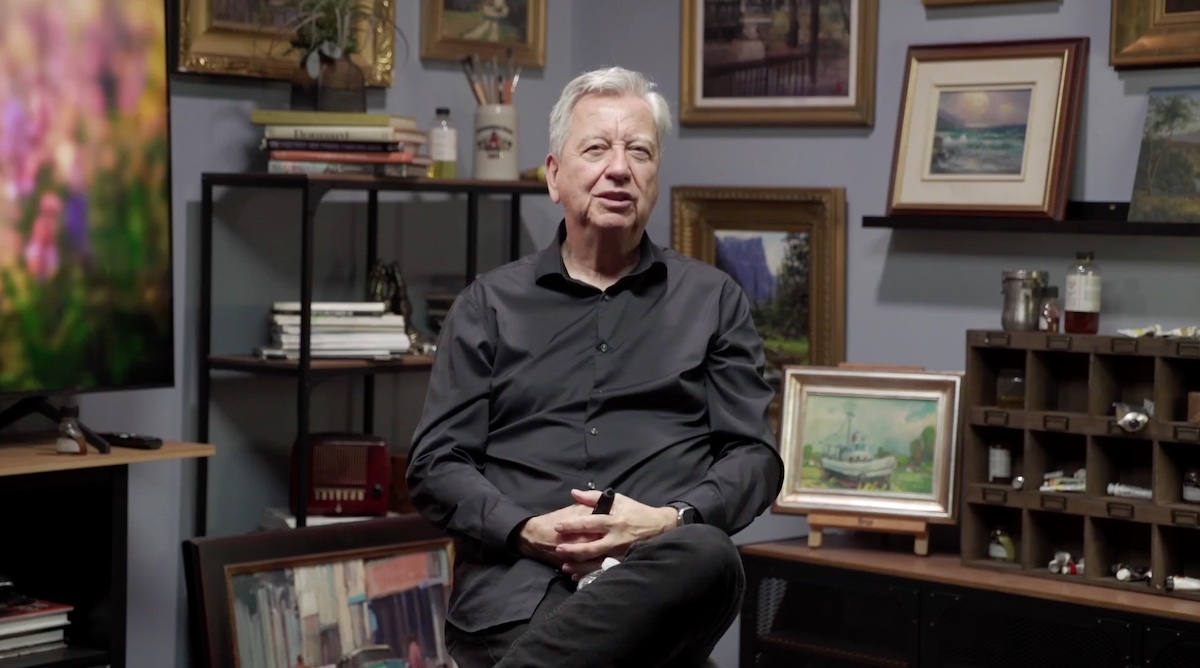
Irish artist Steve Browning demonstrated a plein air session using acrylic paints, with which he completed a painting of the Baily Lighthouse, north of Dublin. “Acrylic paints have a reputation for being the Cinderella of paintings. But if it works for David Hockney, that’s fine with me,” said the artist, who to remedy acrylic’s main problem, which tends to dry very quickly, helped himself with a retarding medium. Browning, habitually prefers to work with a very simple palette with which he tends not to mix colors. He also stated that he does not use a lot of water to dilute the pigment-an important factor this can create frustration for those who are not familiar with this medium. Acrylic according to Browning is a very forgiving medium unlike, for example, oil because it allows one to remove an undesirable texture with simple sandpaper. Moreover, in acrylic drafting, thicker or thinner colors can be used indiscriminately in the various compositional stages because:” acrylic has the great virtue of leaving the artist free,” Browning said. At the end, the artist strongly advised experimenting with plein air acrylic painting: “Don’t paint from pictures: go out and choose a simple scene and paint it on a small scale and have fun,” said the artist who is also the author of a series of old road signs on which he has depicted endangered animals. Indeed, the artist is known in the environment for his anti-poaching efforts to protect endangered species.
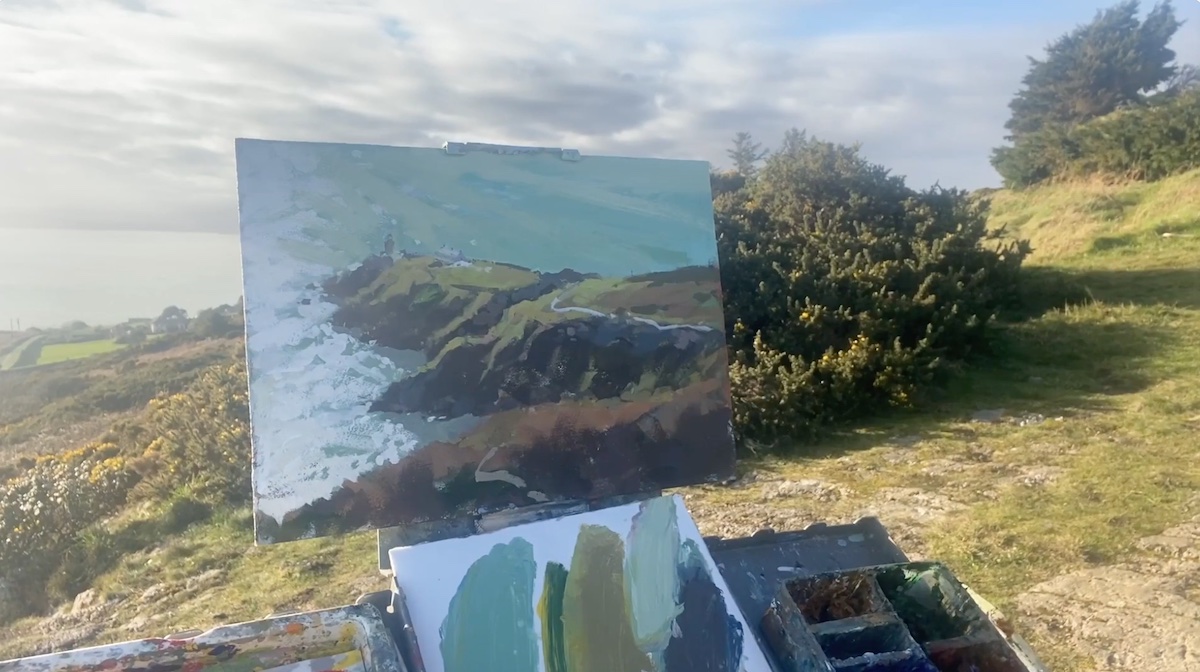
Artist Judd Mercer braved the freezing temperatures in Denver, Colorado, where the 2023 PACE -Plein Air Convention and Expo- will be held in May, to create a plein air gouache composition.
Judd Mercer considers himself:” a perpetual optimizer: lighter, faster, leaner, and more reliable” To prove this statement, he showed participants his necessary equipment for plein air painting: helping himself to an extremely light chair, he made the composition with a “no-easel” configuration in which he hooks two blocks of mixed media paper to the palette resting on his knees as a single “unit.” “Traveling extremely light when making outdoor sessions is crucial,” said the artist.
If he considers himself a “mess” for palette definition, in the demonstration session he was as eloquent in his informative notions as he was in his loquacious presentation of technical steps, which he analyzes by constantly squinting to focus on shapes and tonal values. Performing a drawing in watercolor pencil, he began by laying down the light colors and then dwelt on the dark colors, highlighting them, which he finally emphasized by further darkening adjacent areas. “It’s all about tonal values and gradual color shift,” said the artist who considers gouache a wonderful medium that can simultaneously offer the transparency of watercolor and the opacity of acrylic: “watercolor cannot make colors opaque, acrylic dries too fast, oil can be cumbersome on a small scale, gouache is the optimal solution for me,” said the artist who finished the composition in a continuous balance of warm and cool colors.
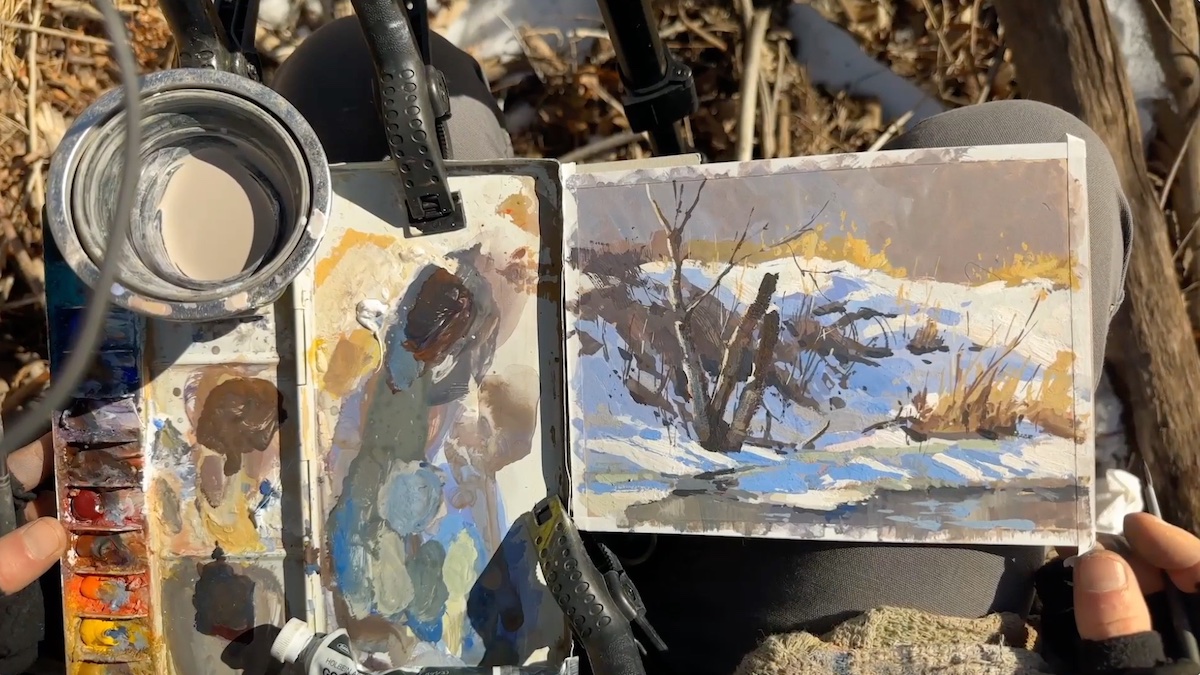
Artist Aline Ordman is an award-winning pastelist and a member of the most prestigious institutions dedicated to pastel painting. From her land in Vermont, she has depicted an excerpt of a snowy mountain landscape. The artist’s love for pastel is due to its versatility, immediacy and brilliance of the medium, made even more visible in the final painting stages. “Although it can be tricky for the inexperienced, especially when dealing with plein air painting, pastel is a medium that can offer great satisfaction,” said the artist.
In the demonstration session, she worked on a toned paper from which she extracted compositional lights. She routinely works using one color at a time that she chooses based on the needs and properties of the colors that take into account: tonal values, temperature and the intensity of the colors. The hand pressure itself is an important element for the artist who tends to use the side of the pastel and about which she said, “I use the side of my medium because I paint from my shoulder not wrist…which gives you a lot of freedom of strokes.”
In the initial drafting, in which she identifies the tonal masses, she did not mix colors and it was only at the end of the composition that she got into the heart of the sections focusing particularly on the sky which she found much more interesting than the wooded landscape in the background.
The choice of colors according to Ordman does not exactly reflect reality, which instead she prefers to interpret according to her emotions.
“It is important to work the whole! That is what gives the color harmony you need, otherwise you might complete an area but it might not relate,” said the artist who managed to capture all the beauty of atmospheric perspective in a harmonious way.
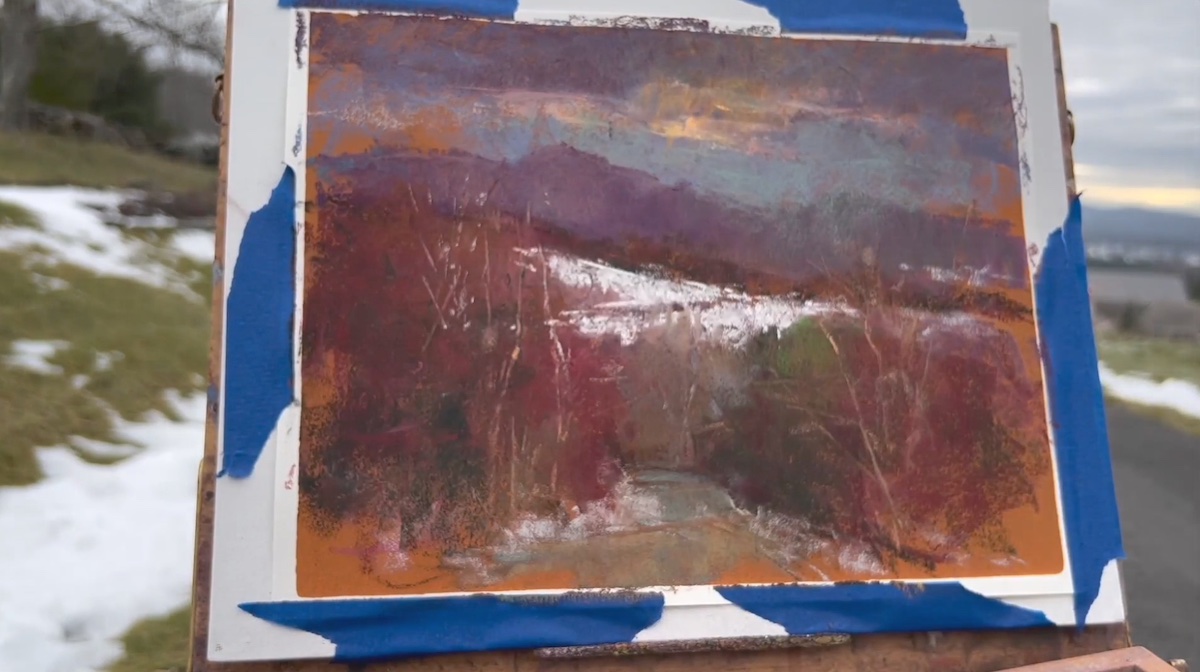
The last artist of the day was Rich Gallego, a teacher with more than 30 years of experience behind him, who depicted, with oil paints, an excerpt of the mountain landscape of County Park in Agua Dulce, CA. The artist, who considers herself a fortunate and grateful person to be able to teach art, has a very particular compositional approach. In fact, Gallego maintains that in an artistic composition, it is necessary to execute a very simple blockin that relates no more than seven tonal zones. An approach that the artist considers simple and straightforward and that is still capable of arousing strong emotions in him, despite the many years he has spent painting.
In choosing the palette, he used few colors-a choice dictated by the need to simplify the composition. Since plein-air painting is based on the need to capture variations in light, it is important, according to Gallego, to fix these variations immediately on the paper. In the architectural composition, played exclusively on tonal and chromatic values, Gallego emphasized the need to execute different shapes and lines in order to create movement within the scene. If in the first part of the process he simply “laid the objects” leaving small spaces in the light areas, in the second part he tried to render the elements as naturally as possible, going along with the rhythms and lines of the natural elements, such as the rocks and mountains. The result was a visually simple yet striking piece.
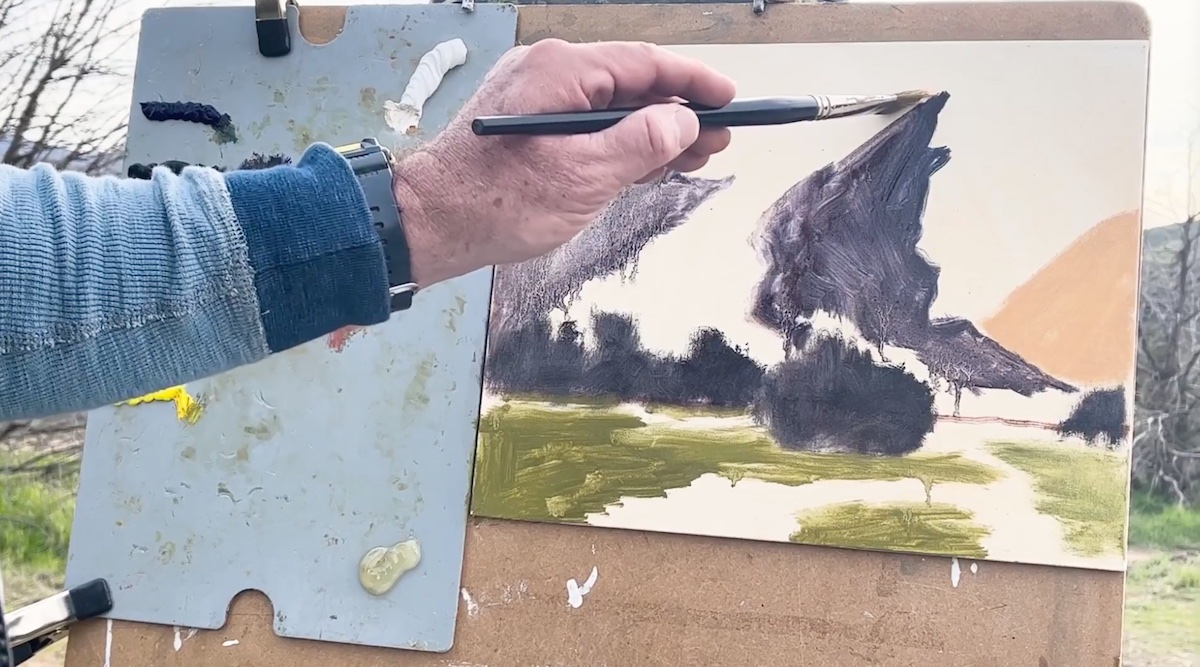
Among the various demonstration sessions there is always space for the many sponsors who have become in effect part of these great events. Among the Platinum Sponsors of Plein Air Live 2023, there could be no shortage of Blick Art Materials, which for its demonstration sessions relied on the expert hands of Susan Kuznitsky, a great pastelist who for many years worked alongside Albert Handell, (one of the most important voices in the American pastel art landscape) and Troy Kilgore originally from Indiana who demonstrated the equipment needed for plein air painting.
All the products presented during the demos are, of course, available on the Blick Art Materials website at the following link: https://www.dickblick.com
Essential Technique day has come to an end and Miami Niche looks forward to seeing you tomorrow to get into the swing of things with the official opening of Plein Air Live, 2023. Follow us.
(on the title: Rich Gallego’s final work painting demonstration)
